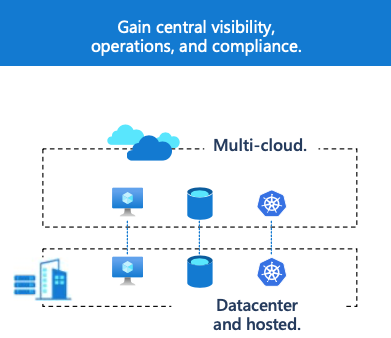Our thoughts on the future of digital innovation and the cloud.

What is Microsoft Azure Arc? Management, app development, and consistent Azure services are all simplified with Microsoft Azure Arc.
- Manage and defend Windows and Linux clusters as well as SQL Servers and Kubernetes services in data centres, on the edge, and in multi-cloud environments from Azure.
- Build cloud-native applications from anywhere with complete visibility and control throughout the whole process.
Arc-enabled Servers vs. Arc-enabled Kubernetes
- Azure Arc-enabled servers: customers can connect Linux and Windows (physical and virtual) machines hosted outside of Azure as a resource with the Azure control plane, similar to how you manage native Azure virtual machines. When a hybrid machine becomes a connected machine to Azure, it is treated as a resource.
- Azure Arc-enabled Kubernetes: customers can attach Kubernetes clusters running anywhere outside of Azure. This includes bare-metal clusters running on-premises, managed clusters such as Amazon EKS and Google Kubernetes Engine, and enterprise PaaS offerings such as Red Hat OpenShift and Tanzu Kubernetes Grid (A Closer Look at Azure Arc).
Common On-prem Challenges
- Patching and upgrades
- Manual DBA tasks
- Scaling on-demand
- No unified view on data assets
- Data security and governance
- Cost management
Azure Arc’s 3 Main Use Cases You May Leverage
Arc lets you accelerate innovation across hybrid and multi-cloud settings by simplifying administration, accelerating app development, and ensuring consistent Azure services across all of your environments.

1) First, if you have workloads operating outside of Azure, you can centrally manage all these resources in Azure, regardless of whether they are on a Windows, Linux, SQL Server, or Kubernetes cluster. To maintain compliance and governance, you can organize assets consistently and get central insight into them from a single pane of glass, all from inside Azure.

2) Next, Azure Arc enables you to create cloud-native programs that can run anywhere and at scale. You can employ contemporary cloud-native app development approaches, which means you can use DevOps techniques to deploy and manage Kubernetes applications at scale on any certified Kubernetes distribution of your choosing. Consistent configuration and policy-driven deployment and operations for apps and Kubernetes clusters may also help to decrease mistakes.

3) And lastly, Azure services such as Azure SQL Managed Instance and Azure PostgreSQL Hyperscale can run from any location. You can use cloud practices and automation to deliver Azure Arc-enabled data services quicker, more reliably, and at scale.
Benefits for Each Personnel
If you have on-premises or public cloud infrastructure, Azure Arc offers a single point of administration for all of it.
- IT administrators/operators: A single pane of glass view of heterogeneous environments and the ability to control and manage these resources consistently is provided for
- Developers: Using familiar technologies and focusing more on the business logic of their apps rather than the infrastructure they are deploying to is a benefit.
- Data scientists and DBAs: Enables them to execute machine learning models everywhere there is data, thanks to cloud automation and built-in features, and always up-to-date databases.
Go Hybrid with Invero
With Azure Arc-enabled services, you can get Azure innovation, cloud benefits and a flexible could-billing model across your data estate. Go hybrid with Invero and bring the cloud to your datacenter with Azure. Connect with us today and let’s talk about our Azure ARC Standard Package offering!


